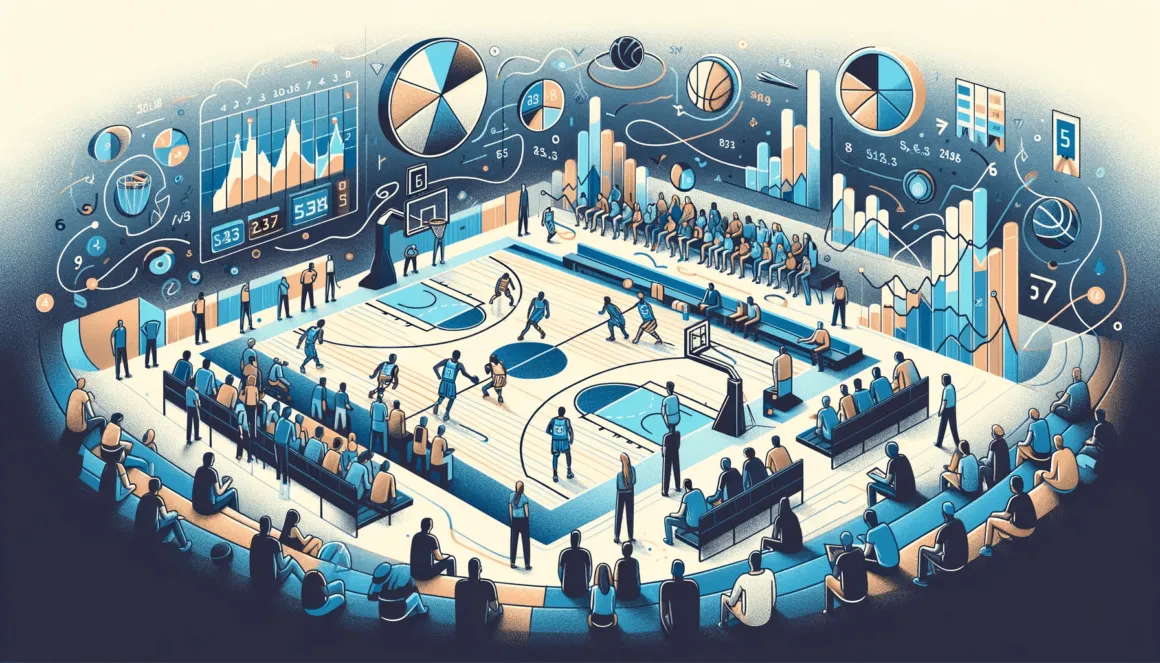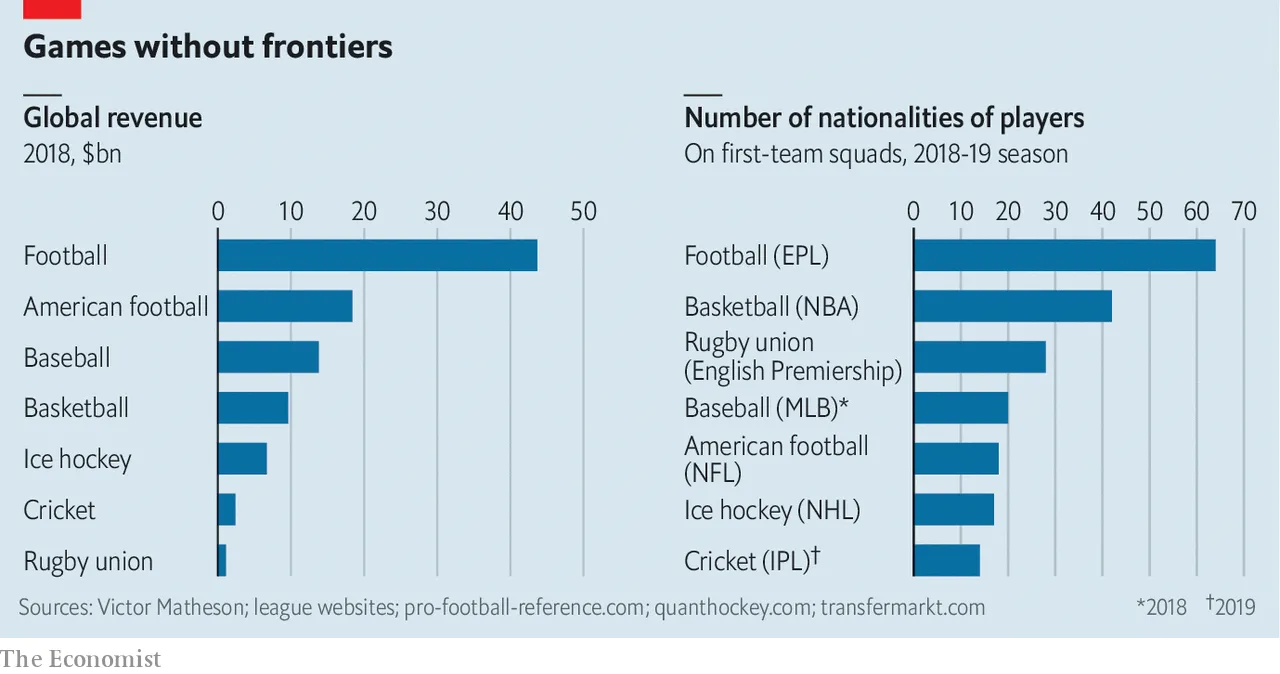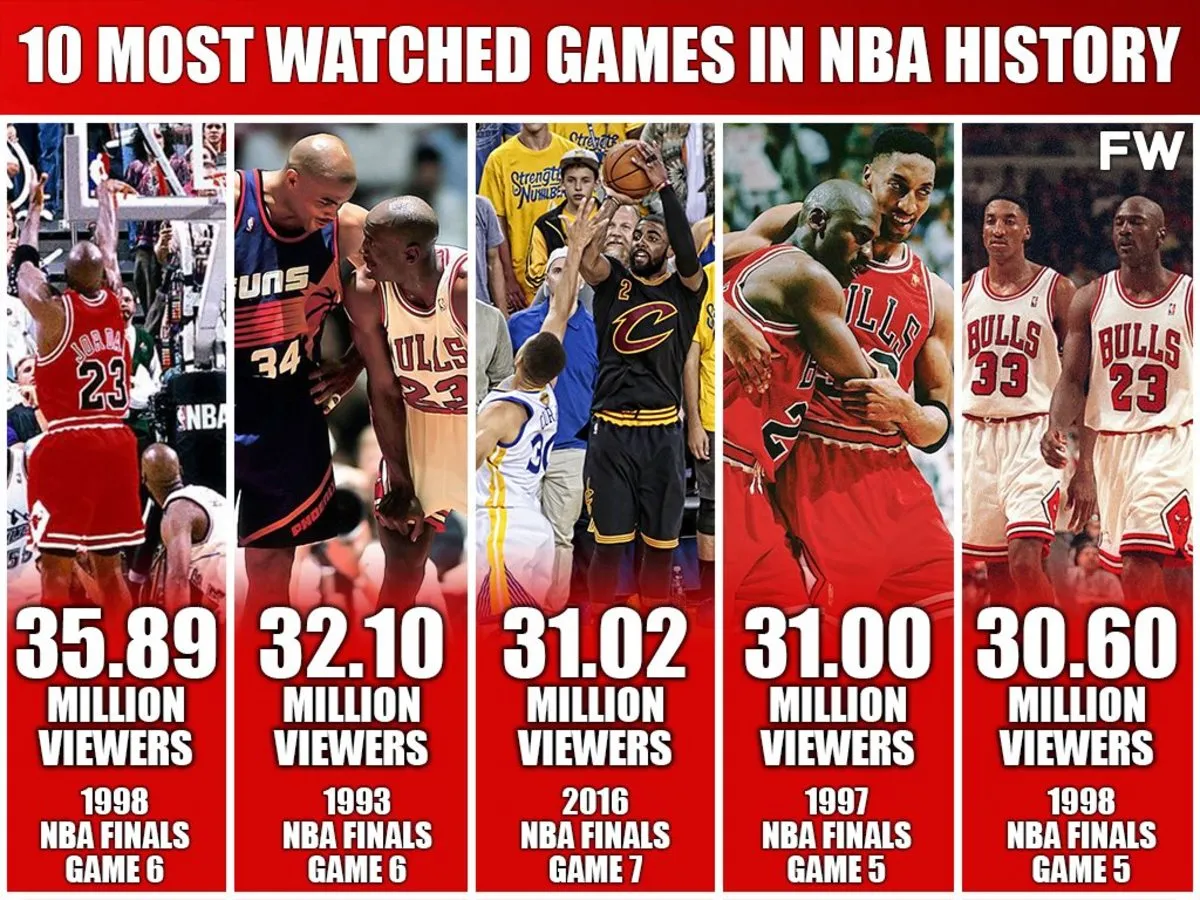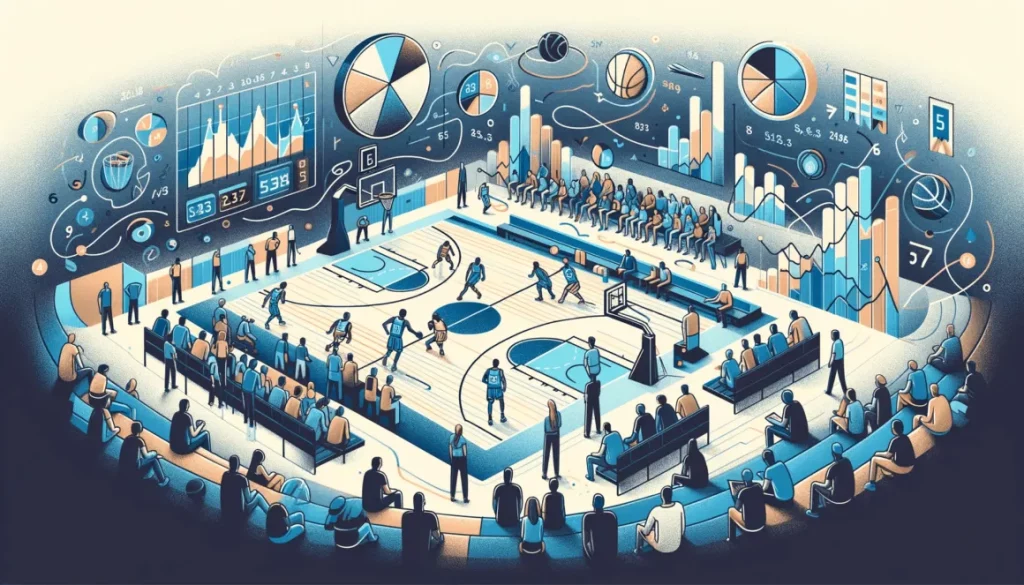Basketball is one of the most popular sports in the world, with a huge following both on and off the court. The NBA (National Basketball Association) is the premier professional basketball league in the world, attracting millions of fans each year to watch their favorite teams and players in action. In recent years, there has been a significant increase in the viewership of NBA games, thanks to the rise of digital media and the growing global interest in the sport.
In this article, we will take a deep dive into the statistics surrounding basketball viewership, specifically focusing on the NBA. We will analyze the trends, patterns, and factors that have contributed to the growth of viewership in recent years. From television ratings to online streaming numbers, we will cover it all in our comprehensive analysis. So let’s get started and explore the fascinating world of basketball viewership statistics.

Overview of NBA Viewership
The NBA has seen a significant increase in viewership over the past decade, with more people tuning in to watch games than ever before. According to a report by Nielsen, the total number of viewers for the NBA games during the 2019-20 season was around 1.5 billion, a 14% increase from the previous season. This surge in viewership can be attributed to various factors such as the popularity of star players like LeBron James and Steph Curry, the rise of social media, and the accessibility of digital platforms for streaming games.
Breakdown by Platform
When it comes to NBA viewership, television has traditionally been the primary medium for watching games. However, with the advent of online streaming services, the landscape has changed significantly. In the 2019-20 season, television still had the largest share of viewership, with an average of 2.1 million viewers per telecast. But digital platforms are quickly catching up, with an average of 1.5 million viewers per game streaming games online or on mobile devices.
The shift towards digital platforms can be seen more clearly when we look at the demographics of NBA viewers. According to a survey conducted by Nielsen, viewers aged between 18-34 years old are more likely to stream NBA games online than watch them on TV. This trend is expected to continue in the future, as younger generations are more inclined towards consuming content on their mobile devices and laptops.
International Viewership
One of the major drivers of the increase in NBA viewership has been the growing global interest in the sport. The NBA has a significant international presence, with games being broadcasted in over 215 countries and territories. In fact, according to a report by Forbes, the NBA games have the highest international viewership among all American sports leagues.
The rise of social media has also played a role in expanding the NBA’s global reach. Platforms like Twitter and Instagram have made it easier for fans around the world to follow their favorite teams and players, creating a sense of community and connection even for those who are thousands of miles away from the action.
Factors Affecting Viewership
Now that we have a general overview of NBA viewership, let’s take a closer look at the factors that have contributed to its growth in recent years.
Star Power
It’s no secret that star players drive viewership in any sport, and basketball is no exception. The NBA has some of the most recognizable and marketable athletes in the world, such as LeBron James, Kevin Durant, and Stephen Curry. These players not only attract fans of their respective teams but also casual viewers who want to witness greatness in action.
The impact of star players on viewership can be seen in the ratings of nationally televised games. According to a study by Nielsen, regular-season games featuring LeBron James had an average of 2.7 million viewers, 18% higher than the average for all nationally televised games. Similarly, games featuring Steph Curry had an average of 2 million viewers, 7% higher than the league average.
Rise of Social Media
Social media has become an integral part of our daily lives, and it has also had a significant impact on how we consume sports media. Platforms like Twitter, Instagram, and YouTube have made it easier for fans to follow their favorite teams and players, get live updates, and engage with other fans in real-time.
The NBA has been at the forefront of leveraging social media to engage with its global fan base. The league has over 100 million followers across its social media accounts, making it the most followed sports league on social media. This has not only helped in increasing brand awareness but has also attracted new fans to the sport.
Accessibility of Games
Another factor that has contributed to the growth of NBA viewership is the accessibility of games through digital platforms. In the past, fans were limited to watching games on television, which meant they could only watch games broadcasted in their local area. But with the rise of online streaming services, fans now have access to every game, no matter where they are located.
The NBA League Pass, the league’s official streaming service, has been a huge success, especially among international audiences. The pass allows fans to watch every game, including the playoffs and finals, for a monthly or yearly subscription fee. With the popularity of cord-cutting and the increasing number of people consuming content online, this has been a game-changer for the NBA.
Impact of COVID-19 on Viewership
The outbreak of COVID-19 in early 2020 forced the NBA to suspend its season for four months, causing a significant disruption in the league’s operations. The pandemic also had a significant impact on viewership, as live games were canceled or postponed, and fans were unable to attend games in person.
Decrease in Traditional Viewership
The suspension of the NBA season in 2020 led to a decrease in traditional viewership numbers. With no live games being broadcasted for four months, TV ratings saw a sharp decline. According to Nielsen, the NBA’s total viewership for the 2019-20 season was down by 10%, with the average viewership per game dropping from 1.5 billion to 1.3 billion.
The lack of live games also had an impact on ticket sales and arena revenue. With no fans allowed in most arenas due to safety concerns, teams saw a significant decrease in their revenue, which is heavily dependent on ticket sales.
Increase in Digital Viewership
While traditional viewership saw a decline, digital viewership witnessed an increase during the pandemic. With fans unable to attend games in person, online streaming became the primary medium for watching games. According to a report by Forbes, the NBA’s League Pass subscriptions increased by 40% during the 2019-20 season restart.
This trend was also seen on social media platforms, as the league’s social media accounts saw an increase in engagement during the pandemic. The NBA’s Instagram account, for example, saw a 16% increase in followers during the season restart.
Comparison with Other Sports Leagues

Basketball is not the only sport that has seen an increase in viewership in recent years. Let’s take a look at how the NBA’s viewership numbers compare to other major sports leagues in the United States.
NFL
The National Football League (NFL) is by far the most popular sports league in the United States, with an average of 16.5 million viewers per game during the 2020 season. The NFL’s massive viewership can be attributed to its popularity among all demographics, strong brand partnerships, and the fact that it only plays games once a week, creating a sense of urgency and exclusivity.
MLB
Major League Baseball (MLB) has experienced a steady decline in viewership in recent years. In the 2019 season, the average number of viewers per game was around 1.4 million, a 4% decrease from the previous year. The decline has been attributed to several factors such as the length of games, lack of star power, and the sport’s perceived slow pace, which may not appeal to younger audiences.
NHL
The National Hockey League (NHL) is another major sports league in the United States, with an average of 5.6 million viewers per game during the 2020-21 season. While the NHL’s viewership is lower than other major sports leagues, it has seen a steady increase over the past few years, thanks to the growth of digital media and the league’s efforts to engage with fans through social media.
Impact on Sponsorship and Advertising
The increase in NBA viewership has had a significant impact on the league’s sponsorship and advertising revenues. With more people watching games, the value of advertising spots and sponsorships has increased, making it a highly lucrative market for brands.
Increase in Sponsorship Deals
The NBA is no stranger to big-name sponsors, with companies like Nike, Coca-Cola, and American Express having long-term partnerships with the league. However, with the rise in viewership, the demand for sponsorships has also increased, leading to the signing of new deals with brands across different industries.
For example, in 2020, the NBA signed a multi-year partnership deal with Microsoft, making the technology giant the official AI and cloud partner for the league. Similarly, the league signed a multi-year partnership with DraftKings, making it the exclusive daily fantasy sports partner of the NBA.
Higher Ad Revenue
The increase in viewership has also led to an increase in advertising revenue for the league and its broadcasting partners. According to a report by Nielsen, during the 2019-20 season, NBA games had the highest advertising revenue per telecast among all major American sports leagues. The average cost for a 30-second ad spot during a nationally televised game was $122,000, a 10% increase from the previous season.
Top Viewed Games and Moments

Basketball, like any other sport, is full of unforgettable moments that leave fans in awe and keep them coming back for more. In this section, we will take a look at some of the top-viewed games and moments in NBA history.
Most Watched Games
The most-watched NBA game of all time was Game 6 of the 1998 NBA Finals between the Chicago Bulls and the Utah Jazz. The game, which aired on NBC, drew in an average of 35.89 million viewers and had a peak audience of 72 million during the final minutes. The game marked Michael Jordan’s last shot as a Chicago Bull, making it a historic moment in NBA history.
Another notable game in terms of viewership was Game 7 of the 2016 NBA Finals between the Cleveland Cavaliers and the Golden State Warriors. The game, which aired on ABC, had an average of 31.02 million viewers and had a peak audience of 44.5 million during the final minutes. It was the first championship win for the Cavaliers and marked the end of the Warriors’ historic 73-win season.
Most Memorable Moments
Apart from entire games, there have been several memorable moments in NBA history that have attracted a large number of viewers. Some of these include:
- Michael Jordan’s “flu game”: During Game 5 of the 1997 NBA Finals, Michael Jordan came down with a severe flu-like illness. Despite being severely ill, Jordan played the entire game and scored 38 points, leading the Bulls to a victory against the Utah Jazz. The game was watched by an average of 29.04 million viewers, making it one of the most-watched games in NBA history.
- Kobe Bryant’s final game: On April 13, 2016, Kobe Bryant played his last game for the Los Angeles Lakers, scoring 60 points against the Utah Jazz. The game was watched by an average of 3.45 million viewers on ESPN, making it the most-watched regular-season game since Michael Jordan’s last game in 2003.
- LeBron James’ first championship win: In 2012, LeBron James won his first NBA championship with the Miami Heat, beating the Oklahoma City Thunder in five games. The series had an average of 16.855 million viewers per game, making it the second-most-watched Finals since 2004.
Future Outlook
The future looks bright for NBA viewership, as the league continues to expand its reach and engage with fans through various platforms. With the rise of digital media and the growing global interest in basketball, there is no doubt that the sport will continue to attract more viewers in the coming years.
Impact of New Media Deals
In 2021, the NBA announced new media deals with its broadcasting partners, including ABC/ESPN and TNT. These deals are reportedly worth $24 billion and will run for nine years, starting from the 2025-26 season. The league’s previous media deals were worth around $9 billion, making this a significant increase in revenue. This increased revenue will not only benefit the league but also its players, who will receive a larger share of the profits.
Expansion into New Markets
The NBA has been actively expanding its global presence, looking to capitalize on the growing international interest in basketball. One of the ways the league has been doing this is by hosting games in other countries, such as China, Japan, and Mexico. The NBA also launched the Basketball Africa League in 2021, which features 12 teams from across the continent.
With the increase in global viewership, we can expect to see more expansion into new markets in the future, leading to a further increase in NBA viewership worldwide.
Growth of Digital Platforms
The shift towards digital platforms for consuming content is only going to accelerate in the future, with younger generations being the primary consumers. This presents an opportunity for the NBA to further engage with its audience and attract new fans through social media, streaming services, and other digital platforms.
In addition to this, the league’s partnership with Microsoft is expected to bring new technologies, such as augmented reality, virtual reality, and AI-powered content, to enhance the viewing experience for fans.
Conclusion
Basketball viewership has seen a significant increase in recent years, thanks to several factors such as star power, rise of social media, accessibility of games, and growing global interest in the sport. While the COVID-19 pandemic did disrupt viewership numbers, the NBA remains one of the most-watched sports leagues in the world.
With the league’s expansion into new markets, the growth of digital media, and the signing of new media deals, the future looks bright for NBA viewership. As long as the league continues to innovate and engage with its fans, there is no limit to how high the numbers can go. So let’s sit back, relax, and enjoy the game as we witness history being made on the court.








